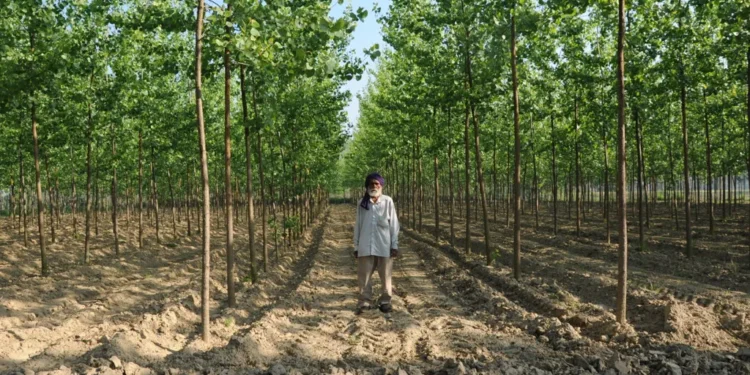This article discusses the benefits of agroforestry and how to incorporate trees into farming operations. Agroforestry is a sustainable land management system that combines the cultivation of trees with crops or livestock.
The practice has numerous benefits, including soil conservation, carbon sequestration, increased biodiversity, and improved crop yields. This article outlines the steps farmers can take to incorporate agroforestry into their operations, including selecting appropriate tree species, managing tree-crop interactions, and utilizing appropriate planting and harvesting techniques.
Agroforestry is a sustainable land management system that combines the cultivation of trees with crops or livestock. The practice has gained increasing attention in recent years due to its numerous benefits, including soil conservation, carbon sequestration, increased biodiversity, and improved crop yields.
Agroforestry can be adapted to a wide range of farming systems and provides a promising solution for meeting the challenges of sustainable agriculture.
What is Agroforestry?

Agroforestry is a sustainable land management system that integrates trees with crops or livestock. The practice involves planting trees in fields, pastures, or other areas where crops or livestock are grown, and managing the interactions between the trees and other components of the farming system.
Benefits of Agroforestry
Agroforestry has numerous benefits, including soil conservation, carbon sequestration, increased biodiversity, and improved crop yields. By integrating trees into farming systems, agroforestry can help to reduce soil erosion, improve soil fertility, and increase water availability. Trees also provide habitat for wildlife and can help to sequester carbon, reducing greenhouse gas emissions.
Selecting Tree Species
When incorporating trees into a farming system, it is important to select appropriate tree species. Trees should be selected based on their compatibility with crops or livestock, their ability to thrive in local conditions, and their desired functions. Trees can be chosen for timber or fruit production, shade or wind protection, or other purposes.
Managing Tree-Crop Interactions
In an agroforestry system, it is important to manage the interactions between trees and crops or livestock.
This includes ensuring that trees do not compete with crops for resources such as water and nutrients and that they do not shade crops excessively.
Trees can also be used to provide shade or wind protection for livestock, and to improve soil fertility through the deposition of leaf litter.
Planting Techniques
When planting trees in an agroforestry system, it is important to utilize appropriate planting techniques. This may include selecting appropriate planting distances and spacing, and ensuring that trees are planted at the appropriate time of year. Techniques such as alley cropping, where trees are planted in rows with crops grown in between, can also be used to maximize the benefits of agroforestry.
Harvesting Techniques
In an agroforestry system, it is important to utilize appropriate harvesting techniques. This may include selective tree harvesting, where only certain trees are harvested to avoid disrupting the balance of the system, or rotational harvesting, where trees are harvested on a cycle to ensure that there are always trees of different ages in the system.
Examples of Agroforestry
Agroforestry can be adapted to a wide range of farming systems and can be implemented on a small or large scale. Examples of agroforestry systems include alley cropping, where trees are planted in rows with crops grown in between, and silvopasture, where trees are planted in pastures to provide shade and improve soil fertility.
Soil Conservation

One of the primary benefits of agroforestry is soil conservation. By incorporating trees into farming systems, agroforestry can help to reduce soil erosion and improve soil fertility. Trees can help to stabilize soil, reducing the impact of wind and water erosion. Additionally, the root systems of trees help to hold soil in place and improve soil structure, making it more resistant to erosion.
Carbon Sequestration
Agroforestry also has the potential to sequester carbon and reduce greenhouse gas emissions. Trees absorb carbon dioxide from the atmosphere during photosynthesis and store it in their biomass and in the soil. By incorporating trees into farming systems, agroforestry can help to sequester carbon and reduce the number of greenhouse gases released into the atmosphere.
Increased Biodiversity
Agroforestry can also help to increase biodiversity on farms. By providing habitat for wildlife, trees can help to support a wide range of plant and animal species. Additionally, by incorporating a variety of crops and trees into farming systems, agroforestry can help to increase genetic diversity and reduce the risk of crop failures due to disease or pests.
Improved Crop Yields
Agroforestry has been shown to improve crop yields in many cases. Trees can provide shade and wind protection for crops, reducing stress and increasing yields. Additionally, trees can help to improve soil fertility, making them more conducive to plant growth.
Challenges of Agroforestry
While agroforestry has numerous benefits, there are also challenges associated with implementing the practice. One challenge is the need for appropriate planning and management. Agroforestry requires careful planning to ensure that trees are planted in the appropriate locations and managed properly to avoid competing with crops for resources.
Funding and Policy Support

Another challenge of agroforestry is the need for adequate funding and policy support. In many cases, farmers may require financial support to implement agroforestry practices. Additionally, policies that support agroforestry can help to promote the adoption of the practice and ensure its long-term sustainability.
Conclusion
Agroforestry is a promising solution for meeting the challenges of sustainable agriculture. By integrating trees into farming systems, agroforestry can help to improve soil conservation, carbon sequestration, biodiversity, and crop yields.
Farmers can take steps to incorporate agroforestry into their operations by selecting appropriate tree species, managing tree-crop interactions, and utilizing appropriate planting and harvesting techniques. With appropriate planning and management, agroforestry can provide a sustainable and resilient solution for meeting the challenges of modern agriculture.










